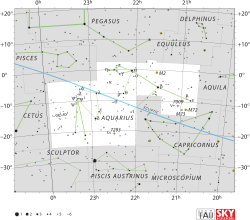106 Aquarii

| |
| Observation data Epoch J2000.0 (ICRS) Equinox J2000.0 (ICRS) | |
|---|---|
| Constellation | Aquarius |
| Right ascension | 23h 44m 12.07893s[2] |
| Declination | –18° 16′ 36.9688″[2] |
| Apparent magnitude (V) | +5.244[3] |
| Characteristics | |
| Spectral type | B9 V[4] |
| U−B color index | –0.239[3] |
| B−V color index | –0.086[3] |
| Astrometry | |
| Radial velocity (Rv) | +14.0[5] km/s |
| Proper motion (μ) | RA: +27.23[2] mas/yr Dec.: –2.94[2] mas/yr |
| Parallax (π) | 8.61 ± 0.54[2] mas |
| Distance | 380 ± 20 ly (116 ± 7 pc) |
| Details | |
| Radius | 2.7–3.2[6] R☉ |
| Rotational velocity (v sin i) | 370[7] km/s |
| Other designations | |
106 Aquarii (abbreviated 106 Aqr) is a star in the equatorial constellation of Aquarius. 106 Aquarii is the Flamsteed designation although it also bears the Bayer designation i1 Aquarii. It has an apparent visual magnitude of +5.2,[3] making it bright enough to be viewed from the suburbs according to the Bortle Dark-Sky Scale. An annual parallax shift of 8.61[2] milliarcseconds yields an estimated distance of around 380 light-years (120 parsecs) from Earth.
The spectrum of this star fits a stellar classification of B9 V,[4] indicating this is a B-type main sequence star. It is spinning rapidly with a projected rotational velocity of 370 km/s.[7] X-ray emission with a luminosity of 6.0 × 1029 erg s−1 has been detected from this star. This is unusual since a B-type star normally does not have any significant X-ray emission. Instead, it may have an undetected lower mass companion.[9]
References
- ↑ Of the grouping of four stars within the circle, 106 Aquarii is the second from the left per:
Sinnott, Roger W.; et al. (1997), Millennium Star Atlas, 3, Sky Publishing Corporation and the European Space Agency, p. 1351, ISBN 0-933346-82-4. - 1 2 3 4 5 6 van Leeuwen, F. (November 2007), "Validation of the new Hipparcos reduction", Astronomy and Astrophysics, 474 (2): 653–664, arXiv:0708.1752
 , Bibcode:2007A&A...474..653V, doi:10.1051/0004-6361:20078357.
, Bibcode:2007A&A...474..653V, doi:10.1051/0004-6361:20078357. - 1 2 3 4 Gutierrez-Moreno, Adelina; et al. (1966), A System of photometric standards, 1, Publicaciones Universidad de Chile, Department de Astronomy, pp. 1–17, Bibcode:1966PDAUC...1....1G.
- 1 2 Houk, Nancy (1978), Michigan catalogue of two-dimensional spectral types for the HD stars, 4, Ann Arbor: Dept. of Astronomy, University of Michigan, Bibcode:1988mcts.book.....H.
- ↑ Wielen, R.; et al. (1999), Sixth Catalogue of Fundamental Stars (FK6). Part I. Basic fundamental stars with direct solutions (35), Astronomisches Rechen-Institut Heidelberg, Bibcode:1999VeARI..35....1W.
- ↑ Pasinetti Fracassini, L. E.; et al. (February 2001), "Catalogue of Apparent Diameters and Absolute Radii of Stars (CADARS) - Third edition - Comments and statistics", Astronomy and Astrophysics, 367: 521–524, arXiv:astro-ph/0012289
 , Bibcode:2001A&A...367..521P, doi:10.1051/0004-6361:20000451.
, Bibcode:2001A&A...367..521P, doi:10.1051/0004-6361:20000451. - 1 2 Royer, F.; et al. (February 2007), "Rotational velocities of A-type stars. III. Velocity distributions", Astronomy and Astrophysics, 463 (2): 671–682, arXiv:astro-ph/0610785
 , Bibcode:2007A&A...463..671R, doi:10.1051/0004-6361:20065224.
, Bibcode:2007A&A...463..671R, doi:10.1051/0004-6361:20065224. - ↑ "106 Aqr -- Star", SIMBAD, Centre de Données astronomiques de Strasbourg, retrieved 2012-07-15.
- ↑ Hubrig, S.; et al. (June 2001), "Search for low-mass PMS companions around X-ray selected late B stars", Astronomy and Astrophysics, 372: 152–164, arXiv:astro-ph/0103201
 , Bibcode:2001A&A...372..152H, doi:10.1051/0004-6361:20010452.
, Bibcode:2001A&A...372..152H, doi:10.1051/0004-6361:20010452.